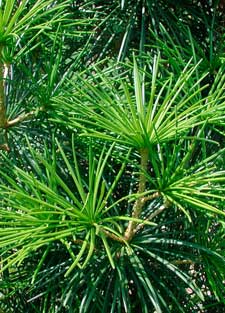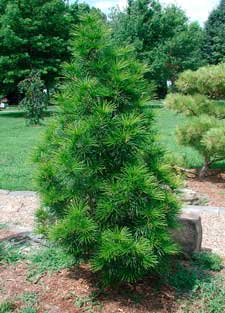Resource Library
Plant of the Week: Umbrella Pine, Japanese
The University of Arkansas System Division of Agriculture does not promote, support or recommend plants featured in "Plant of the Week." Please consult your local Extension office for plants suitable for your region.
Plant of the Week
Umbrella Pine
Latin: Sciadopitys verticillata

That the world is ever changing is not news, but most mere mortals find it difficult to wrap our minds around the notion of change on a geological scale.
During the Triassic period - the age before even dinosaurs had appeared - the land masses of earth looked nothing like they do today. Just as the physical geography has changed, so have the plants that cover the land. A few, such as the Japanese umbrella pine (Sciadopitys verticillata), have survived from those long lost epochs and provide a living link with the really old days.
Japanese umbrella pine is not a pine at all but a coniferous evergreen now classified in its own family (the Sciadopitaceae) with no close relatives amongst now extant plants. It branched off from the trunk of the tree of life sometime around 250 million years ago, and it and its then-numerous relatives succeeded in covering wide swaths of land that was to become in our time Eurasia, northern Europe and the northern reaches of North America.
But as the earth changed, its range and species diversification shrank until today this once successful family is now restricted to just one species growing in cool cloud forests of central Japan between 1,500 and 3,000 feet.
In nature, it grows as a 120-foot tall tree with a tall, unbranched cinnamon red trunk and a topknot of foliage. But, because it’s so slow growing - often making only 6 inches of growth a year - few landscape trees in this country are more than 35 feet tall. These youngsters retain their foliage to the ground in a more or less pyramidal fashion like most conifers.

Umbrella pine - a name probably coined by Francis Parkman during the Civil War - has a whorl of stiff, plastic-like evergreen needles at the ends of each shoot that radiate out and resemble the spokes of a Japanese umbrella. The needles have a top and bottom groove and are 2 to 5 inches long.
Francis Parkman (1823-1893) was an historian living in Boston who’s still remembered today for his lively, firsthand report of his trip on the Oregon Trail in 1846. Gardening was Parkman’s other passion, and it was he who first grew the Japanese umbrella pine outside of Japan. George Hall, a physician turned Oriental trader, sent Parkman a shipment of plants in 1861, including the first Japanese maples grown in this country.
The umbrella pine is one of the “five trees of Kiso,” a selection of five species of coniferous forest giants made during the feudal period and used as plantings around shrines and important sites. One of these umbrella pines has been worshiped locally at the Jinguji Temple in Kyoto Prefecture since 1310.
Japanese umbrella pines are hardy from zones 5 to 7, so are best suited for use in the cooler parts of Arkansas. Light shade from pine trees or afternoon shade is preferable, but they will grow in full sun so long as they remain well watered during summer droughts. They grow best in rich, fertile sites with an acidic soil pH.
Because Japanese umbrella pines are so slow growing, use them as specimens in a rock garden or even as part of the foundation planting. It’s a pricy and unique species, so use it as a prominent specimen.
By: Gerald Klingaman, retired
Extension Horticulturist - Ornamentals
Extension News - January 26, 2007
The University of Arkansas System Division of Agriculture does not maintain lists of retail outlets where these plants can be purchased. Please check your local nursery or other retail outlets to ask about the availability of these plants for your growing area.